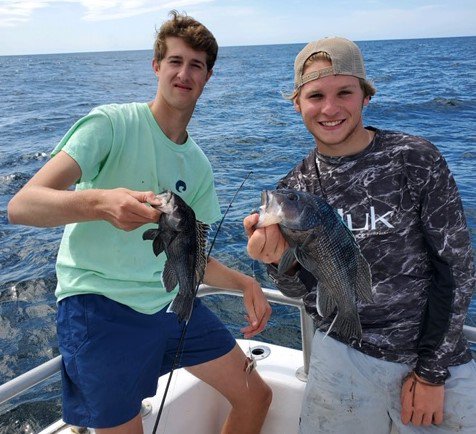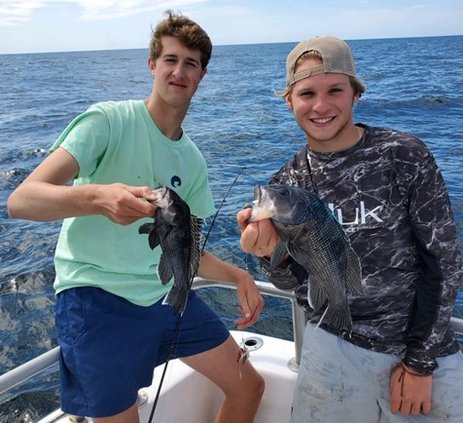Inshore report
Our inshore captains have been doing a great job of keeping up with the inshore bite. Why? Well, even when they are not taking out trips they are fishing. And to find a fish, to catch a fish and be able to keep one, you got to be in the know. What does this mean? Well, as you all know them fish got fins and they use them. This means they are never in one place very long and neither is the food source that they are feeding on.
The best news is that where you caught most of your fish last year, they once again are right back in the same area. All you have to do is get the old log book out and flip back to 2019 at the same month and BAM! You will know the whereabouts of fish.
I told you keeping a log book could turn into a priceless affair!
For those that want to target red fish, spotted sea trout and flounder, also known as the “Savannah slam,” it is time. The absolute best bait, as you all must know, is live shrimp. However, it is a known fact, especially at this time of the year, once you get the bite a going, it is very easy to switch to salt impregnated artificial shrimp patterns. For those inshore fishermen that want some light-tackle, real-hard, fast-pulling, line-stretching action, the bonnet head sharks have arrived.
What does all of this mean? The spring bite has arrived for sure.
Artificial reefs (50-70 feet of water)
Well, my dear offshore fishermen, the time has come for us to have a little more action, which means we got mid-water fish biting action.
Bottom fishing has been very active especially for catching and releasing. And as you all know, that can be lots of fun too.
For those fishermen that want to do a little bottom fishing, I suggest using cut fish, cut squid or dead shrimp. Now I must add that those wanting to use dead shrimp for bait should bring a lot of it with you. It seems that offshore fish has perfected the job of taking this bait off without even giving you a heads up much less a little tickle on your line.
I suggest using squid, because it’s tough, stays of the hook, keeps the same stinky smell, it’s hard for a fish to get it off the hook, and most likely during this chewing processing the fish will get hooked up. And isn’t that what us fishermen are looking for in a bait in the first place?
While bottoming fishing at the artificial reefs, I have been catching black sea bass, sand perch, rock bass, sheepshead head, black drum, trophy red fish, flounder and pig fish.
Don’t laugh, a pig fish can be quite entertaining. Just the noise it makes alone makes for the beginning of a great offshore conversation piece.
I have found that the artificial reefs located in less than 50 feet of water are still holding some nice sheepshead. The reefs located in deeper water are holding some nice keeper black sea bass.
Offshore report
Offshore fishermen now have fish-catching options. Heck, if you don’t want to bottom fish, trolling and pitching is now a catching option. All sizes of blue fish arrived about three weeks ago and this bite has been very good on the bottom. If you want some pulling action, give this fish a try on light tackle.
Now the mackerel have arrived and I am talking about the Spanish and the kings. So our offshore options have just been turned up a notch.
We caught some really nice size blue fish, Spanish mackerel, King mackerel, little tunny and Bonita while strolling and trolling last week.
What were we using as bait? I call it old school tools! I pulled single 0 and double 00 Clark spoons behind assorted size planers from 1-3 inches. I also pulled these spoons behind 2-ounce trolling sinkers also known as trout sinkers.
The leader lengths between spoons and planers were about 10 feet. When pulling sinkers with spoons, the leader length was 6 to 10 feet. I was using 20 to 30 pound test monofilament line as leader.
I suggest, especially when dealing with these seriously toothy fish, that you always check your leader every time you land a fish. The reason being is these fish quite often miss the spoon and hit the leader and even the main line.
I suggest pulling the line through your closed fingers, if you feel a nick, cut it out and retie. In other words, if you get a nick, you have been hit. This area most likely will not last through another hit meaning your spoon will be gone.
I always have my customers ask, “Why don’t you use wire leader?” The answer is always simple and direct: “Wire leader seems to detour the fish bite.”
What does this mean? (And this always makes for a great conversation piece) If you use wire leader you will not lose your spoons for sure. Why? You won’t get that many hits in the first place.
You decide whether A word on king mackerel
In the king mackerel catching world, we catch the “snakes,” which are king mackerel that weigh in at 9 pounds or less. The next size up would be the “teenagers,” which weigh in between 13 and 19 pounds. Although a 19-pound king mackerel is really a nice fish, we still call it a teenager. Then we have the “slingers,” which are mackerel big enough you can’t just grab the leader and sling them in the cooler. Of course, going this route means that you are using a substantial leader. If using light tackle, I suggest using the gaff.
When we are trolling with 3.5-inch Drone spoons, which are attached to an 80-pound test leader, we just throw the fish in the box. And here’s the thing about this: After throwing the fish in the box with Drone spoon is mouth, I suggest giving it plenty of slack. Why? After a few flips the king with throw the spoon and all you have to do is grab the leader and pull the lure out of the box. It is as simple as that.
After all this slinging, if your next king mackerel is too big to sling, then it is called a “gaffer.” This fish should fall somewhere between 20 to 30 pounds, which is a looker for sure.
Now after 30 pounds, your king mackerel is called a “smoker.” Why? When it hits your bait, whether it is being trolled or not, it screams line off at an amazing rate. This fish is so strong, fast, big and determined that it pulls the line off the reel so fast that it looks like it is smoking.
Another name for a smoker is “big brown eyes.” Why this nick name? Well, a large smoker is sporting some darn big brown eyes, which can see everything before it hits your bait.
This big fish doesn’t use its eyes to see any flaws in your bait. This brings to light that a big king mackerel’s brown eyes allow them to see way out in front of its speed, meaning it has already determined when it arrives whether or not it is going eat.
Savannah Snapper Banks
The bottom fishing is great! Our boats have been catching black sea bass, trigger fish, vermilion snapper, white grunt, almaco jacks, banded rudder fish, amberjack, genuine red snapper, (season closed) grouper (season closed) king/ Spanish mackerel, cobia, mega sharks, small composite sharks, as well as other biters. The bottom line is if you want to catch and not just fish, it is time to make a Savannah Snapper Banks run.
Gulf Stream
It is time to go! A strong bite pattern for tuna, mahi mahi or Wahoo has not developed yet, but this could happen any day now. Why? Time and the approaching temperatures are on our side.
Believe it or not: Texas Tower cobia
The tower’s name was the “Texas Tower.” It was located at the end of the Tybee Roads shipping channel. A lot of charter and recreational boats used this tower as a point of reference and also as a place that seemed to always hold the attention of some sort of fish from big to small. Not only was it a fish haven, it was also used as a navigational aid. I can always remember this tower either being on my right or left when I was headed out fishing. On this particular day at the age of 14, I decided to take my charter group to the tower to do a Spanish mackerel trolling trip. When I arrived at the tower, there was an 18foot outboard already tied to the tower. This meant I only had three sides to work with, which wasn’t such a problem in the ‘60s. There were lots of fish to be had. So around and around the tower we went. Every time we circled we would give a wave to the lone fisherman who wore a large straw hat. He always waved back with a smile.
Upon our third or fourth time around the tower I notice that the lone fisherman had hooked up. His rod was bending over almost into the water and he was struggling. We now had something other than the tower to watch. After all, my fishing techniques weren’t working.
After about 30 minutes or so the lone fisherman got his fish to the boat. I noticed that he didn’t have a gaff much less a net. A little wave action helped him get the big fish into his boat. What happened after that was well worth watching.
The large fish was a cobia that must have been over 80 pounds. At any rate, the first thing to fly out of his boat was a cooler lid, then a boat cushion. As the lone fisherman retreated to a safer area, which was the top of his outboard, his hat blew off into the water.
There he sat, in the sun while the large cobia took his boat apart. Somehow the large fish managed to get out of the boat. We picked up all of the things that were floating around the lone fisherman’s boat, including his large wet straw hat.
As I approached the small boat, the lone fisherman, who looked a little haggard said, “That fish was probably too tough to eat anyhow.” I had to agree, especially at this point of the fishing game!
Thanks for reading and be safe!
Capt. Judy Helmey can be reached at 912-897-4921 and www.missjudycharters. com.

